新西兰 英语国家文化的选修课 课件
- 格式:ppt
- 大小:3.23 MB
- 文档页数:15
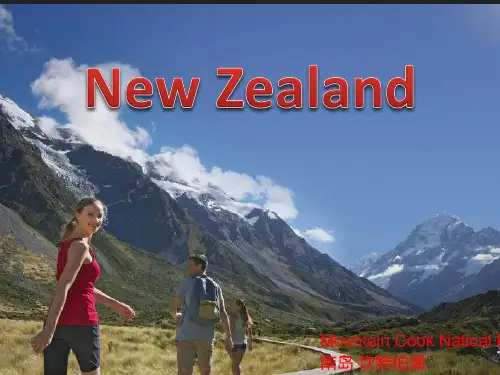

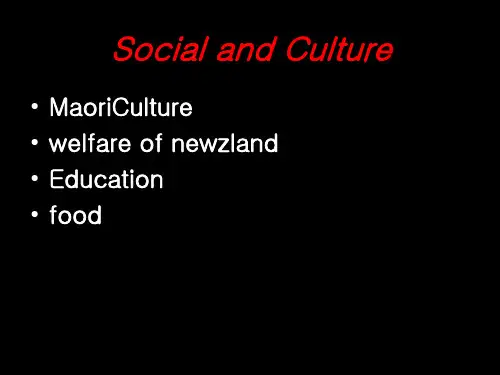
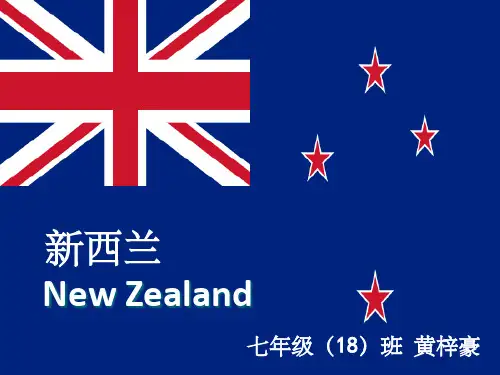
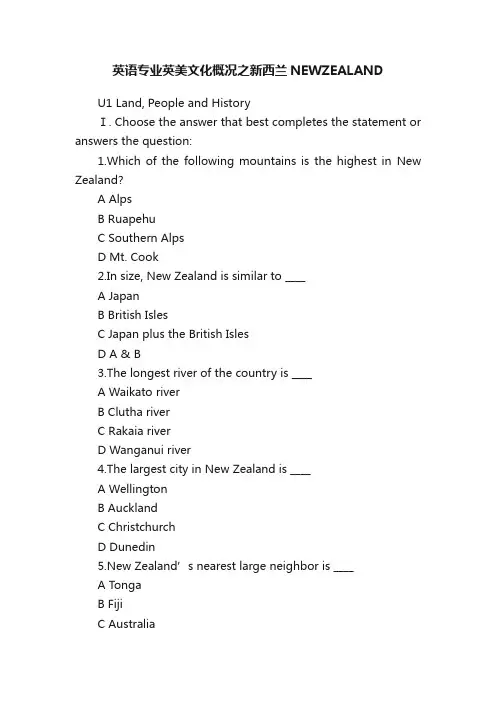
英语专业英美文化概况之新西兰NEWZEALANDU1 Land, People and HistoryⅠ. Choose the answer that best completes the statement or answers the question:1.Which of the following mountains is the highest in New Zealand?A AlpsB RuapehuC Southern AlpsD Mt. Cook2.In size, New Zealand is similar to ____A JapanB British IslesC Japan plus the British IslesD A & B3.The longest river of the country is ____A Waikato riverB Clutha riverC Rakaia riverD Wanganui river4.The largest city in New Zealand is ____A WellingtonB AucklandC ChristchurchD Dunedin5.New Zealand’s nearest large neighbor is ____A TongaB FijiC AustraliaD Argentina6.In April 2006, New Zealand became the first country to declare ____ as an official language.A EnglishB MaoriC sign languageD Polynesian language7.Which one of the following is the most common religion?A ChristianityB Roman CatholicC MethodistD Anglican8. Which country is the first one in the world to give women the right to vote?A AmericaB SwedenC AustraliaD New ZealandⅡ.Decide whether the following statements are true(T) or false(F):1. Maori people today resist adopting western life. ( )2. The North Island has been formed mostly by active volcanoes. ( )3. There are no nuclear power plants or weapons in New Zealand. ( )4. Because of the gold boom, people in the North Island have been more than in the South since 1896. ( )5. Wellington is the world’s largest Polynesian city. ( ) Ⅲ.Fill in the blanks:1. New Zealand is in the _________________________________2. The two main land masses in the country are _________________ and ___________________3. The first piece of environmental legislation ---_________________came into effect in 1991, in which ________________________ is reflected.4. New Zealand was settled over 1000 years ago by _________ from __________________ .5. In 1840, Maori chiefs signed the ______________________ to keep their ownership of the natural, and in return, to give up the right to govern to the __________________ .6. The national bird of NZ is _________________.7. In 1769, ________________ visited New Zealand and claimed it for Britain,U2 Political System, Education and EconomyⅠ. Choose the answer that best completes the state ment or answers the question:1.The two main parties in the House of Representatives are______A the Progressive Party and the Labor PartyB the Labor Party and the National PartyC the Green Party and the NZ First PartyD the United Future NZ Party and the National Party2.The Head of State of New Zealand is______A the Prime MinisterB the Governor GeneralC the British monarchD the Ombudsman/doc/189491683.html,cation in New Zealand is compulsory between the ages of ______A 5---15B 6---16C 7---17D 6---114. The economy of NZ largely relies on _______A overseas tradeB agricultureC fishingD forest5. The electricity in NZ mainly depends on_______A riversB geothermal steamC windmillsD natural gas6. Which one is not in the largest exporters of NZ?A meatB dairy productsC woolD woodⅡ.Decide whether the following statements are true (T) or false (F):1. New Zealand has no written constitution. ( )2. An Act of Parliament can become law without the Governor-General’s agreement.( )3. The largest school in NZ is the Correspondence School. ( )4. NZ is one of the world’s largest fishing areas. ( )5. About 70% of exports going to Pacific Rim members of the APEC grouping. ( )6. The sea food industry is the third biggest export earner. ( )7. NZ is the only one country in the world where farming is not subsidized by the state. ( ) 8. There are 20 forest parks, 7 inthe North Island and 13 in the South Island. ( ) Ⅲ.Fill in the blanks:1. Since 1950, Parliament has had a single chamber, the_____________________.2.The three levels of local government are ______________ , _____________and ______________ .3. New laws begin as documents called _______. Parliament considers several different types of bill in formal stages. If they pass through all those stages they become _________, called ______________________.4. NZ now has four major markets: ________, __________________, ________ and ________.5. Cereals such as wheat, barley and oats are grown in __________________; maize in ______.6. The pillar industries of NZ are _________. ____________,____________, ______________.。
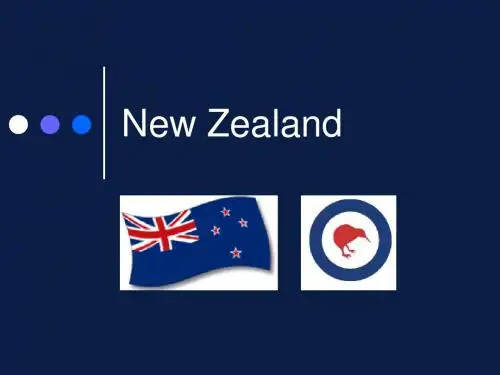
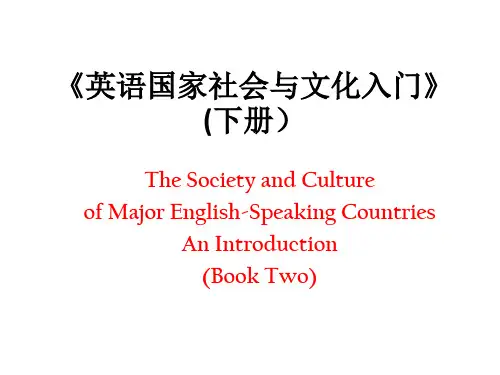


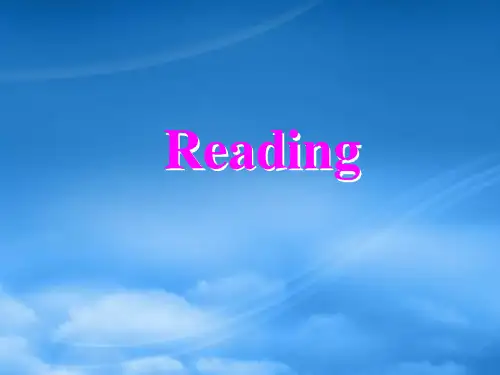

Culture of New ZealandI.New Zealand General CultureThe culture of New Zealand is largely inherited from British and European custom, interwoven with Maori and Polynesian tradition. (1) An isolated Pacific Island nation, New Zealand was comparatively recently settled by humans. Initially Maori only, then bicultural with colonial and rural values, now New Zealand is a cosmopolitan culture that reflects its changing demographics, is conscious of the natural environment, and is an educated, developed Western society.More recently, New Zealand culture has been broadened by globalization and immigration from the Pacific Islands, East Asia and South Asia. European and Maori remain the two largest ethnicities, but the large Polynesian population in Auckland has prompted the observation that Auckland is now the largest Polynesian city in the world. However, the country outside of Auckland is still much less heterogeneous, with big parts of the South Island remaining predominantly of European descent.New Zealand marks two national days of remembrance, Waitangi Day and ANZAC Day, and also celebrates holidays during or close to the anniversaries of the founding dates of each province. The national anthem, "God Defend New Zealand" is often sung with alternating Maori and English verses. Many citizens prefer to minimize ethnic divisions, simply calling themselves New Zealanders or Kiwis.II.Maori CultureMaori culture has predominated for most of New Zealand's history of human habitation. Maori voyagers reached the islands of New Zealand some time before 1300, though exact dates are uncertain. The Maori settled the island and developed a distinct culture.Maori oral history tells of a long voyage from Hawaiki in large ocean-going canoes. Maori mythology is a distinctive corpus of gods and heroes, sharing some Polynesian motifs. Some notable figures are Rangi and Papa, Maui, andKupe.Over the ensuing centuries of Maori expansion and settlement, Maori culture diverged from its Polynesian roots. Maori established separate tribes, built fortified villages, hunted and fished, traded commodities, developed agriculture, arts and weaponry, and kept a detailed oral history. Regular European contact began approximately 200 years ago, and British immigration proceeded rapidly during the nineteenth century. (2)The colonists had a dramatic effect on the indigenous Maori, bringing religion, technology, and the English language. In 1840 Maori leaders signed the Treaty of Waitangi, intended to enable the tribes to live peacefully with the colonists. However after several incidents, the treaty was ignored and the New Zealand land wars broke out from 1845, with Maori suffering a loss of land and identity, while also increasingly becoming a minority group over the following century. Despite such setbacks, Maori culture has regained much of its lost influence in recent decades. III.New Zealand European CultureNew Zealand European culture derives mainly from that of the British settlers ,its people called Pakeha who colonized New Zealand in the nineteenth century. Although it is recognizably related to British culture, it has always had distinct differences, and these have increased as time has gone on. Things which distinguish European culture from British culture include higher levels of egalitarianism, anti-intellectualism, and the idea that most people can do most things if they put their minds to it. Within European culture are sub-cultures derived from Irish, Italian and other European groups, as well as various non-ethnic subcultures. (3) It has been claimed that Pakeha do not actually have a culture, or if they do it is not a distinct one. Part of the problem is that high culture is often mistaken for culture in general, and the lack of recognition historically given to New Zealand's artists, writers and composers is seen as evidence of a lack of culture.IV.Relationship Between Maori Culture And New Zealand European CultureThese two kinds of culture in New Zealand are not totally independent. In fact, Maori borrow from European culture, so do European culture, they interact each other. But during this process, there is always existing a lot of conflicts, sometimes they all hold their own stance, reject to receive the other one’s culture. Gladly, the situation changes better between them, they have realized how to respect each other, and how to get along with each other harmoniously.On one hand, since the early stages of colonization, Maori have been receptive adopters of aspects of European culture. From the 1830s many Maori converted to Christianity and in the process learned to read and write, to the extent that it has been claimed that in mid nineteenth century New Zealand, Maori were more likely to be literate than Pakeha. A number of religions, such as Pai Marire and Ringatu, arose in the nineteenth century, blending Maori tradition and Christianity (4). Similarly Maori traditional chants were put to Victorian music, or written to European tunes, European designs and metal tools adopted by carvers, altering their style and British fabrics and cloth, such as blanketing adopted to form new dress. The horse was adopted, particularly on the East coast. European tools and particularly weapons were frequently decorated with traditional motifs, for example wooden musket and rifle stocks acquired elaborate carving. From the 1820s Maori began building vessels in the European boat building tradition. Many of these activities were conducted in collaboration with Pakeha traders and settlers.From the 1860s, the adoption of Pakeha culture became less of a free choice as Pakeha began to outnumber Maori. A Pakeha-dominated parliament had free rein to pass legislation affecting Maori, such as the Native Schools Act which required English to be the dominant medium of instruction for Maori children. So, while majority of Maori encouraged their children to learn the English language and Pakeha ways of life in order to function economically and socially, Maori were pushed as well as pulled into changing culture. From the early twentieth century and especially from the 1970s, Maori began to protest against this Eurocentrism and demanded equal recognition for their own culture.One the other hand, since the late nineteenth century, Pakeha have used many ofits forms when they required something distinctively New Zealand. The most famous example of this is the haka of the All Blacks, a Maori posture dance which is performed before international rugby matches, there are many non-Maori Polynesian All Blacks, thus making this a multi-ethnic borrowing. However Pakeha artists such as Colin McCahon and Gordon Walters have also incorporated Maori motifs into their art, and a number of early Pakeha writers used Maori themes and topics in an effort to create an authentically New Zealand literature. The tourist industry has also made heavy use of Maori culture in an effort to present tourists with distinctly New Zealand experiences and items. This may show that Pakeha are not entirely confident that they have a culture of their own, or if they do, that it is interesting or distinct. Many Pakeha in other countries use Maori culture in order to express their New Zealandness, even if they take little interest in Maori while in New Zealand. An example of this is the mass haka which takes place in Parliament Square in London every Waitangi Day. Although Maori are generally involved, most participants are Pakeha.For many years Pakeha did not consult Maori over the use of their culture, and Maori generally did not protest loudly unless a symbol was being used in a particularly inappropriate way. From the 1970s, Maori began increasingly to object to Pakeha use of their culture, especially when this use was disrespectful or ignorant. One example of this is the 'haka party incident' of 1979. University of Auckland engineering students had a tradition of performing an obscene mock haka at graduation. After pleas from Maori students to discontinue the practice were ignored, a group assaulted the engineering students. They were later charged with assault but defended by Maori elders who testified that the engineers' haka was deeply offensive.Most Pakeha are now more respectful of Maori culture and often consult Maori before using Maori cultural forms. However despite some attempts to copyright cultural intellectual property this does not always occur and forms are still sometimes used in inappropriate ways.V.Other Contents in New Zealand CultureA.Customs in New ZealandIn New Zealand, when people meet or say goodbye, they all shake hands with each other. In common, they have straight eye contact and shaking hands tightly. A man should wait for a woman’ hand first, besides this, bowing and heading up are also their courtesy. At the fist meet, people who have the same identity call each other last name, and add Mr./Miss, after they are familiar with each other, they will call him by his first name. And Maori still has strong traditional customs. When they meet the honored guests, both parties should touch the tip twice or three times. According to the custom, it is said that the longer you touch the nose, the higher the treatment, the more popular.New Zealanders often have strong time concept, date shall be agreed in advance, be punctual for appointment. Guests can arrive a few minutes early to show their respect to the host. Their daily talks always refer to climate, sports, domestic and foreign political, tourism and so on. Avoid about personal things, such as religion, race, and so on. Meeting a visitor is generally in the office, the person who is invited to visit a New Zealand home can give the host a box of chocolate or a bottle of whisky, and give the hostess a bunch of flowers, the present shouldn’t be too much or too expensive.Because most local residents are English descents, therefore, the spread of custom here is English body language and gestures. They are dissatisfied with the hubbub and striking an attitude excessively. Chewing gum or using toothpicks in public are considered not civilized behaviors. New Zealanders take European dining way, always a fork in left hand, a knife in right hand.New Zealand life rhythm is slower, people’s life is carefree. For different classes, the opening of the market and the rich products give them a range of options, but seen from an overall consumption level, New Zealanders pursue high-grade goods, shopping tend to famous brands.New Zealanders’characters are formal, serious, even watching a movie, often separate men from women to a different time. Restrictions on alcohol is strict, the restaurant licensed to sell alcohol can only sell wine, in the restaurant which can sell alcohol, the guest must buy a dinner so he is allowed to drink a cup of. However, beersales in New Zealand are quite large, the fifth, it is to say that per person drink 110 liters of beer per year.B.Convention in New ZealandNew Zealand’s legal age of marriage is 16 one full year of life, but before 18 one full year of life, it needs parents’agreement and guardianship. For Maori, before puberty, they are just naked in front of their mothers, they can have a trial marriage, if they are satisfied with each other after living together and getting their parents’ agreements, as long as the woman live in the man’s home a night ,they are married. And another thing for marriage, December 9, 2004, more than half of New Zealand parliament voted to pass the homosexuals and cohabitation of citizens who may enjoy the combination with legal couples in equal legal status.Under the climate condition, in most occasions, people can take leisure clothing, most restaurants and snacks places are accepted guests with leisure clothing. Men generally need not wear a suit and tie, only a few top formal restaurants of the big city and bar exception.In New Zealand, there are 14 manors for vacation listed in the Small Luxury Hotels of the World. What’s more, many other throughout New Zealand delicate hotels provide high quality accommodation, which usually located an untraversed region. Now more and more hotels provide spa.(1)/wiki/Culture_of_New_Zealand访问时间2011,11,22,18:19(2)/wiki/Culture_of_New_Zealand访问时间2011,11,22,18:19(3)/wiki/Culture_of_New_Zealand访问时间2011,11,22,18:46(4)/wiki/Culture_of_New_Zealand访问时间2011,11,22,18:46(5)/view/10151.htm访问时间2011,11,22,19:00新西兰文化-百度百科(6)/view/497e67ec5ef7ba0d4a733bf5.html访问时间2011,11,22,19:00婚礼习俗(7)《新西兰社会与文化》,王素华主编,武汉大学出版社,2007(8)《新西兰:历史、民族与文化:Its History, People and Culture》,赵晓寰,乔雪瑛著,复旦大学出版社,2009(9)《太平洋上的璀璨明珠:新西兰》,赵友斌,林知著,四川大学出版社,2000。
-1-课标导航文本感知谈论地理特征、气候、文化、人口等(Talking about geographical features,climate,culture,population,etc)The North Island has a range of mountains running through themiddle of the island,with gently sloping farmland on either side. It rains very heavily in this area,which has an annual rainfall of over 7,500 mm,an ideal environment for spectacular forests andfarming.Most moved to the North Island,where the climate was better for growing sweet potatoes and fern roots for food・课标导航文本感知课标导航文本感知课标导航文本感知Y 観鬆H trnI •阅读NEW ZEALAND LAND OF THE LONG WHITE CLOUD,完成下列问题。
1 .There are lots of earthquakes and volcanoes in New Zealand becauseA. New Zealand has two tectonic plates which are constantly movingB. New Zealand has many volcanoesC. New Zealand sits on two tectonic plates which are seldom movingD. New Zealand sits on two tectonic plates which are constantly moving2. The Central Plateau is CA. on one side of the North IslandB. on one side of the South IslandC. in the centre of the North IslandD. in the centre of the South Island课标导航3.Most Maori people came to live in New Zealand in about E ・A.1000 ADB.1000 AD-1200 ADC.1000BCD.1200 BC-1000BC4.What can we know from this passage? AA.The environment of New Zealand was changed greatly by English settlers ・B.The Maori signed a treaty with Britain and lived peacefully from then on.C.The Maori and Europeans fought only between 1860-1872.D.The Southern Alps is on the North Island・5.What can we infer from this passage? CA.The Plateau is the site of sweet potatoes.B.The English settlers called their new home Aotearoa・C.The Maori people fought with each other.D.To protect themselves,the people began to live in houses.Y観鬆H口•阅读NEW ZEALAND TRAVEL GUIDE,完成下列问题。